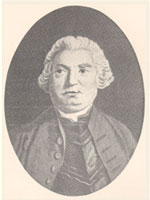Charles Lawrence (British Army officer)
Charles Lawrence | |
|---|---|
Halifax, Nova Scotia | |
| Allegiance | British |
| Rank | Brigadier general |
| Battles/wars | |
| Other work | Governor of Nova Scotia |
Brigadier-General Charles Lawrence (14 December 1709 – 19 October 1760) was a British military officer who, as
Early career
Lawrence was born in Plymouth (Devon) on 14 December 1709. He followed his father, General Charles John Lawrence, who is said to have served in Flanders under John Churchill, 1st Duke of Marlborough, into a military career.
Charles Lawrence's earlier life is obscure. He was commissioned in the
Father Le Loutre's War

During
French and Indian War

During the
Lawrence commissioned several armed patrol vessels to patrol the Nova Scotia coast as part of a provincial marine, including the ten-gun brigantine Montague in 1759.
As governor of Nova Scotia, Lawrence saw the settlement of the Acadian lands by
He is said to have died of pneumonia in 1760 in

According to his biographer, Dominique Graham,
Referring to the monument raised to Lawrence’s memory in St Paul’s Church, Halifax, to indicate the late governor’s popularity, Belcher wrote, "In a grateful sense of his affection and services the last tribute that could be paid to his memory was unanimously voted by the General Assembly at their first meeting after the late Governor’s universally lamented decease." These sympathetic remarks by a contemporary with whom Lawrence had sometimes been at odds and the considerations mentioned above should be placed in the scales against the views of historians who condemn him for his inhumanity to the Acadians.[4]
Legacy
- He is the namesake of Fort Lawrence, Nova Scotia and Lawrencetown, Nova Scotia, Lawrence St in Lunenburg
- namesake of a British privateer Lawrence[5]
See also
- Military history of Nova Scotia
- Military history of the Mi’kmaq People
- Military history of the Acadians
References
Endnotes
- ^ Griffiths (2005), p. 120.
- ^ Griffiths (2005), p. 420.
- ^ Griffiths (2005), p. 423.
- ^ Graham (1974).
- ^ MacMechan, Archibald (1920). The Log of a Halifax Privateer. Halifax: H.H. Marshall. p. 6.
Texts
- ISBN 978-0-7735-2699-0.
- Brasseaux, Carl A. (1987). The Founding of New Acadia: The Beginnings of Acadian Life in Louisiana, 1765–1803. Louisiana State University Press. ISBN 978-0-8071-4163-2.
- Brasseaux, Carl A. (1991). "Scattered to the Wind": Dispersal and Wanderings of the Acadians, 1755–1809. Center for Louisiana Studies, University of Southwestern Louisiana. ISBN 978-0-940984-70-7.
- Brasseaux, Carl A. (1992). Acadian to Cajun: Transformation of a People, 1803–1877. University Press of Mississippi. ISBN 978-1-61703-111-3.
- Graham, Dominick (1974). "Lawrence, Charles". In Halpenny, Francess G (ed.). Dictionary of Canadian Biography. Vol. III (1741–1770) (online ed.). University of Toronto Press.
- Rushton, William F. (1979). The Cajuns: From Acadia to Louisiana. Noonday Press.
- British critique of Lawrence for military government. 1756
